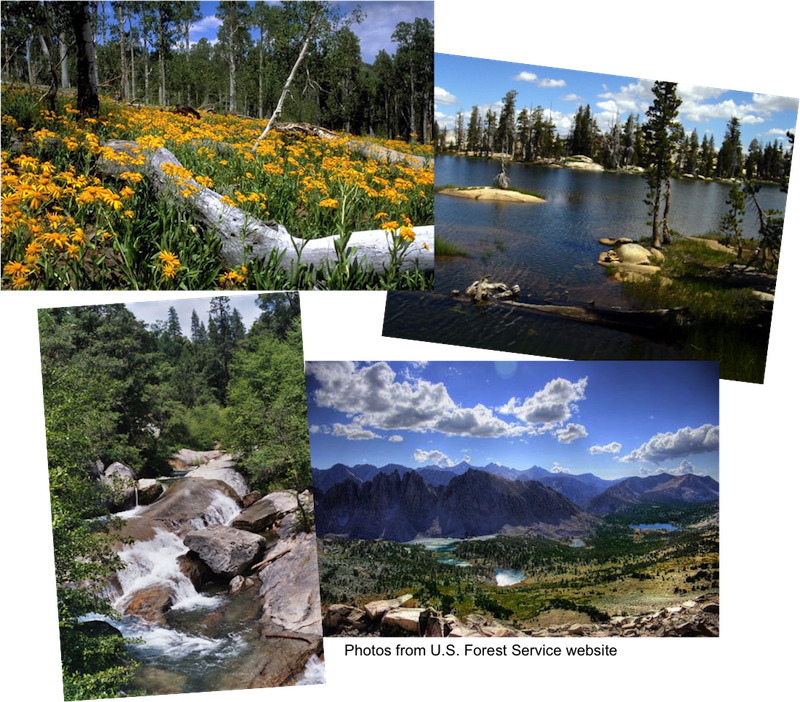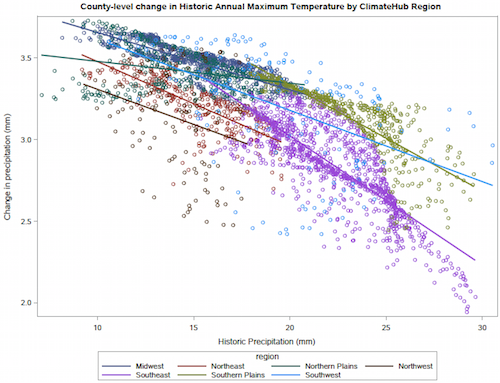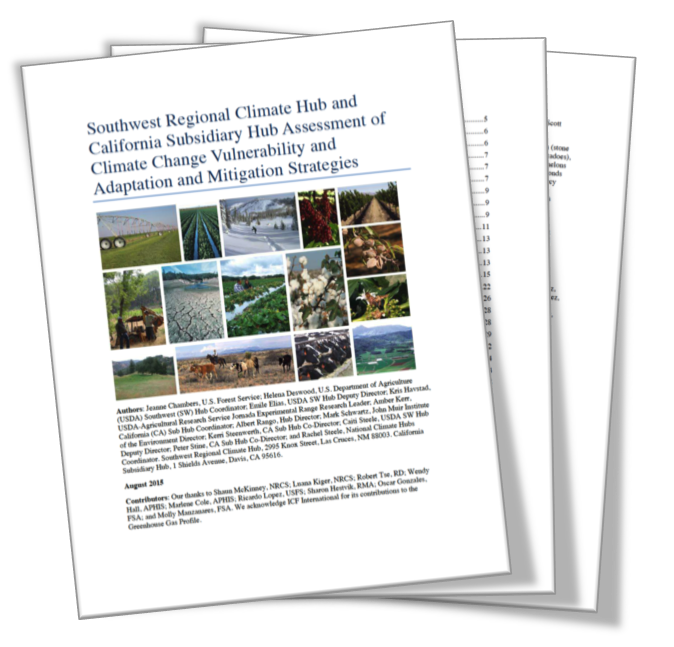- Data
- Videos
-
Publications & Research
-
Education
- Water Conservation Data Jam - Curriculum for 6th-12th Grade Students
- Climate Change and Wildfire – Curriculum Unit for 9-12 Grade Students
- Climate Change and the Carbon Cycle – Curriculum Unit for 9-12 Grade Students
- Where's Our Water? Water Conservation in the Southwest - Lesson for 6-8 Grade Students
- Climate Change and the Water Cycle - 10-Hour Curriculum Unit for 6-12 Grade Students
- The Effects of Climate Change on Agricultural Systems - 5-Hour Curriculum Unit for 6-12 Grade Students
- Cambio climatico y el ciclo del agua
- Webinars and Online Courses
- Websites
- News & Events
- About Us
- RMA
Focus on Forestland
|
Climate change is increasing the vulnerability of many forests through the interacting effects of warmer temperatures and drought with insects and fire regimes. Temperature across the southwest are increasing and are projected to rise by 1-3˚C by 2050 and by 2-4˚C by 2100 (IPCC 2013). Drought stress associated with rising temperatures is expected to increase throughout the southwest due to effects of higher evapotranspiration, even if precipitation remains constant (Fung et al. 2011) or increases slightly (Seager et al. 2007). Consequently, the areas with suitable climate to support current forest types are projected to either (1) shift northwards or upwards in elevation, for example, California evergreen forest and woodland and Rocky Mountain conifer forest or (2) contract, for example, juniper and pinyon woodlands (Rehfeldt 2012). The distributions of forest species are already being affected at their trailing edges by dieback and mortality as shown for Populus tremuloides (Worrall et al. 2008, Rehfeldt et al. 2009, Michaelian et al. 2011, Aneregg et al. 2013), Pinus ponderosa (Gitlin et al. 2006), and Pinus edulis (Shaw et al. 2005, Breshears et al. 2005). The response of forest species to a warming environment will depend on the rate and magnitude of climate change, and the capacity of individual species to disperse to establish in newly suitable areas. Interactions with insects and pathogens will influence both the effects of climate warming and the capacity of forest species to respond to the change. Native bark beetles (Coleoptera: Curculionidae, Scolytinae) evolved with forest species in the southwest, and several bark beetle species have the capacity to cause landscape-scale tree mortality (Bentz et al. 2010). Climate warming has increased the incidence of bark beetle outbreaks in part by decreasing the amount of time required to produce a generation of beetles in a particular location (Hansen et al. 2001, Werner et al. 2006, Bentz and Schen-Langenheim 2007). In addition, drought-stress can reduce the defensive capacity of trees and, thus, the number of beetles necessary for a successful attack (Bentz et al. |
2010). The interacting effects of drought and bark beetle infestations can result in regional-scale vegetation die-off. In southwestern woodlands, as much as 90% of the dominant overstory tree species (Pinus edulis) died in 2002-2003 in response to drought and associated bark beetle infestations (Breshears et al. 2005). Similarly, sudden aspen decline (SAD) has caused rapid, widespread branch dieback and mortality of quaking aspen (Populus tremuloides Michx.) as a result of drought. Several species of pathogens and insects, including Cytospora canker, bronze poplar borer, and aspen bark beetles were correlated with crown loss and other factors related to SAD (Marchetti et al. 2011). Climate change is already shifting forest fire regimes outside of the historical range of variability. Large wildfires increased suddenly and markedly in the mid-1980s, with greater frequency of large wildfires, longer wildfire durations, and longer wildfire seasons (Westerling et al. 2006, Littell et al. 2011). The greatest increases occurred in mid-elevations and are strongly associated with increased spring and summer temperatures and earlier spring snowmelt. Changes in southwest forests may involve both climate and land-use effects. In these forests, large changes in moisture deficits are strongly associated with advances in the timing of spring (Westerling et al. 2006), but this area also includes substantial forested area where fire exclusion, timber harvesting, and succession after mining activities have led to increased forest densities and fire risks (Allen et al. 2002, Gruell 2001). Thus, although land-use history is an important factor for wildfire risks in specific forest types (such as some ponderosa pine and mixed conifer forests), the broad-scale increase in wildfire frequency across the western United States has been driven primarily by sensitivity of fire regimes to recent changes in climate over a relatively large area. Please see http://www.usda.gov/oce/climate_change/effects_2012/FS_Climate1114%20opt.pdf for more information on forests of the southwest. |

References
- Allen, C. D., Savage, M., Falk, D. A., Suckling, K. F., Swetnam, T. W., Schulke, T., . . . Klingel, J. T. (2002). Ecological Restoration of Southwestern Ponderosa Pine Ecosystems: A Broad Perspective. Ecological Applications, 12(5), 1418-1433.
- Anderegg, W. R., Placová, L., Anderegg, L. D., Hacke, U. G., Berry, J. A., & Field, C. B. (2013). Drought's legacy: multiyear hydraulic deterioration underlies widespread aspen forest die-off and portends increased future risk. Global Change Biology, 19(4), 1188-1196. doi:10.1111/gcb.12100
- Bentz, B. J., & Schen-Langenheim, G. (2007). The Mountain Pine Beetle and Whitebark Pine Waltz: Has the Music Changed? Proceedings of the Conference Whitebark Pine: A Pacific Coast Perspective.
- Breshears, D. D., Cobb, N. S., Rich, P. M., Price, K. P., Allen, C. D., Balice, R. G., . . . Meyer, C. W. (2005). Regional vegetation die-off in response to global-change-type drought. Proceedings of the National Academy of Sciences, 102, pp. 15144-15148. doi:10.1073/pnas.0505734102
- Fung, F., Lopez, A., & New, M. (2011). Water availability in +2°C and +4°C worlds. Philosophical Transactions of The Royal Society A: Mathematical, Physical, & Engineering Sciences, 369(1934), 99-116. doi:10.1098/rsta.2010.0293
- Gitlin, A. R., Sthultz, C. M., Bowker, M. A., Stumpf, S., Paxton, K. L., Kennedy, K., . . . Whitham, T. G. (2006). Mortality gradients within and among dominant plant populations as barometers of ecosystem change during extreme drought. Conservation Biology, 20(5), 1477-1486.
- Gruell, G. E. (2001). Fire in Sierra Nevada Forests: A Photographic Interpretation of Ecological Change Since 1849. Missoula, Montana: Mountain Press Publishing Company.
- IPCC. (2013). Climate Change 2013: The Physical Science Basis. Contribution of Working Group I to the Fifth Assessment Report of the Intergovernmental Panel on Climate Change. Cambridge, UK and New York, NY, USA: Cambridge University Press.
- Littell, J. S., McKenzie, D., Peterson, D. L., & Westerling, A. L. (2009). Climate and wildfire area burned in western U.S. ecoprovinces, 1616-2003. Ecological Applications, 19(4), 1001-1021. doi:10.1890/07-1183.1
- Marchetti, S. B., Worrall, J. J., & Eager, T. (2011). Secondary insects and diseases contribute to sudden aspen decline in southwestern Colorado, USA. Canadian Journal of Forest Research, 41(12), 2315-2325. doi:10.1139/x11-106
- Michaelian, M., Hogg, E. H., Hall, R. J., & Arsenault, E. (2011). Massive mortality of aspen following severe drought along the southern edge of the Canadian boreal forest. Global Change Biology, 17(6), 2084-2094. doi:10.1111/j.1365-2486.2010.02357.x
- Rehfeldt, G. E., Crookston, N. L., Sáenz-Romero, C., & Campbell, E. M. (2012). North American vegetation model for land-use planning in a changing climate: a solution to large classification problems. Ecological Manage, 22(1), 119-141. doi:10.1890/11-0495.1
- Rehfeldt, G. E., Ferguson, D. E., & Crookston, N. L. (2009). Aspen, climate, and sudden decline in western USA. Forest Ecology and Management, 258(11), 2353-2364. doi:10.1016/j.foreco.2009.06.005
- Seager, R., Ting, M., Held, I., Kishnir, Y., Lu, J., Vecchi, G., . . . Naik, N. (2007). Model Projections of an Imminent Transition to a More Arid Climate in Southwestern North America. Science, 316(5828), 1181-1184. doi:10.1126/science.1139601
- Shaw, J. D., Steed, B. E., & DeBlander, L. T. (2005). Forest Inventory and Analysis (FIA) annual inventory answers the question: What is happening to pinyon-juniper woodlands? Journal of Forestry, 103(6), 280-285.
- Werner, R. A., Holsten, E. H., Matsuoka, S. M., & Burnside, R. E. (2006). Spruce beetles and forest ecosystems in south-central Alaska: A review of 30 years of research. Forest Ecology and Management, 227(3), 195-206. doi:10.1016/j.foreco.2006.02.037
- Westerling, A. L., Hidalgo, H. G., Cayan, D. R., & Swetnam, T. W. (2006). Warming and Earlier Spring Increase Western U.S. Forest Wildfire Activity. Science, 313(5789), 940-943. doi:10.1126/science.1128834
- Worrall, J. J., Egeland, L., Eager, T., Mask, R. A., Johnson, E. W., Kemp, P. A., & Shepperd, W. D. (2008). Rapid mortality of Populus tremuloides in southwestern Colorado, USA. Forest Ecology and Management, 255(3-4), 686-696. doi:10.1016/j.foreco.2007.09.071









